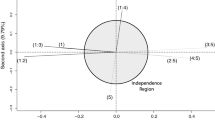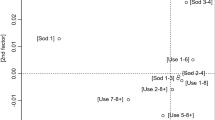Abstract
Within the non-iterative procedures for performing a correspondence analysis with linear constraints, a strategy is proposed to impose linear constraints in analyzing a contingency table with one or two ordered sets of categories. At the heart of the approach is the partition of the Pearson chi-squared statistics which involves terms that summarize the association between the nominal/ordinal variables using bivariate moments based on orthogonal polynomials. Linear constraints are then included directly in suitable matrices reflecting the most important components, overcoming also the problem of imposing linear constraints based on subjective decisions.
Similar content being viewed by others
References
AGRESTI, A. (1996), An Introduction to Categorical Data Analysis, New York: Wiley.
AMENTA, P., SIMONETTI, B., and BEH, E.J. (2008), ”Single Ordinal Correspondence Analysis with External Information”, Asian Journal of Mathematics and Statistics, 1, 34–42.
BEH, E.J. (1997), ”Simple Correspondence Analysis of Ordinal Cross-Classifications Using Orthogonal Polynomials”, Biometrical Journal, 39, 589–613.
BEH, E.J. (1998), ”A Comparative Study of Scores for Correspondence Analysis with Ordered Categories”, Biometrical Journal, 40, 413–429
BEH, E.J. (2001), ”Partitioning Pearson’s Chi-Squared Statistic for Singly Ordered Two-Way Contingency Tables, The Australian and New Zealand Journal of Statistics, 43, 3, 327–333.
BEH, E.J., and D’AMBRA, L. (2009), ”Non-Symmetrical Correspondence Analysis with Concatenation and Linear Constraints”, Journal of Classification, 26, 55–76.
BENZECRI, J.P. (1980), Practique de l’analyse des donnees (Vols. 1-3), Paris: Dunod.
BEST, D.J., and RAYNER J.C.W. (1994), ”Analysis of Ordered Contingency Tables via Orthogonal Polynomials”, Department of Applied Statistics, University of Wollongong, Australia.
BEST, D.J., and RAYNER J.C.W.(1996), ”Nonparametric Analysis for Doubly Ordered Two-Way Contingency Tables”, Biometrics, 52, 1153–1156.
BÖCKENHOLT, U., and BÖCKENHOLT, I. (1990), ”Canonical Analysis of Contingency Tables with Linear Constraints”, Psychometrika, 55, 633–639.
BÖCKENHOLT, U., and TAKANE, Y. (1994), ”Linear Constraints in Correspondence Analysis”, in Correspondence Analysis in the Social Sciences: Recent Developments and Applications, eds. M. Greenacre and J. Blasius, New York: Academic Press., pp. 70–111.
DAVY, P.J., RAYNER, J.C.W. and BEH, E.J. (2003), ”Generalised Correlations and Simpson’s Paradox”, in Modelling and Simulation Research, eds. V. Pemajayantha, R.W. Mellor, S. Peiris, and J.R. Rajasekera, Blacktown, N.S.W.: Modelling and Simulation Research, pp. 63–73.
EMERSON, P.L. (1968), ”Numerical Construction of Orthogonal Polynomials from a General Recurrence Formula”, Biometrics, 24, 696–701.
ESCOUFIER, Y., and JUNCA, S. (1986), ”Discussion of Paper by L. A. Goodman”, International Statistical Review / Revue Internationale de Statistique, 54, 3, 279–283.
FISHER, R.A., and YATES, F. (1963), Statistical Tables for Biological, Agricultural and Medical Research, London: Oliver and Boyd.
GILULA, Z. (1986), ”Grou** and Association in Contingency Tables: An Exploratory Canonical Correlation Approach”, Journal of the American Statistical Association, 81, 395, 773–779.
GILULA, Z., and HABERMAN, S.J. (1986), ”Canonical Analysis of Contingency Tables by Maximum Likelihood”, Journal of the American Statistical Association, 81, 780–788.
GILULA, Z., and HABERMAN, S.J. (1988), ”The Analysis of Multivariate Contingency Tables by Restricted Canonical and Restricted Association Models”, Journal of American Statistical Association, 83, 760–771.
GOODMAN, L.A. (1985), ”The Analysis of Cross-Classified Data Having Ordered and/or Unordered Categories: Association Models, Correlation Models, and Asymmetry Models, for Contingency Tables With or Without Missing Entries”, The Annals of Statistics, 13, 10–69.
GOODMAN, L.A. (1996), ”A Single General Method for the Analysis of Cross-Classified Data: Reconciliation and Synthesis of Some Methods of Pearson, Yule, and Fisher, and Also Some Methods of Correspondence Analysis and Association Analysis”, Journal of the American Statistical Association, 91, 408–428.
GREENACRE, M.J. (1984), Theory and Applications of Correspondence Analysis, New York: Academic Press.
HABERMAN, S.J. (1979), Analysis of Qualitative Data (Vol. 1), New York: Academic Press.
HWANG, H., and TAKANE,Y. (2002), ”Generalized Constrained Multiple Correspondence Analysis”, Psychometrika, 67, 215–228.
LANCASTER, H.O. (1953), ”A Reconstitution of χ 2 Considered from Metrical and Enumerative Aspects”, Sankhya, 13, 1–10.
LEBART, L.,MORINEAU, A., and Warwick, K.M. (1984), Multivariate Descriptive Statistical Analysis: Correspondence Analysis and Related Techniques for Large Matrices, New York: Wiley.
LOMBARDO, R., BEH, E.J., and D’AMBRA, L. (2007), ”Non-Symmetric Correspondence Analysis with Ordinal Variables Using Orthogonal Polynomials”, Computational Statistics and Data Analysis, 52, 1, 566–577.
NISHISATO, S. (1980), ”Analysis of Categorical Data: Dual Scaling and Its Applications”, Toronto: University of Toronto Press.
RAO C.R. (1964), ”The Use and Interpretation of Principal Component Analysis in Applied Research”, Sankhya, A, 26, 329–359.
RAO, C.R. (1973), Linear Statistical Inference and Its Applications, New York: Wiley.
RAYNER, J.C.W., and BEST, D. J. (1995), ”Extensions to Some Non-Parametric Tests”, in Proceedings of the A. C. Aitken Centenary Conference, eds. L. Kavalieris et al., Dunedin: University of Otago Press, pp. 257–266.
RAYNER, J.C.W., and BEST, D.J.. (1996), ”Smooth Extensions of Pearson’s Product Moment Correlation and Spearman’s Rho”, Statistics and Probability Letters, 30, 171–177.
SROLE, L., (1962), Mental Health in the Metropolis: The Midtown Manhattan Study, New York, McGraw-Hill.
TAKANE, Y., and JUNG, S. (2009), ”Regularized Non Symmetric Correspondence Analysis”, Computational Statistics and Data Analysis, 53, 3159–3170.
TAKANE, Y., and SHIBAYAMA, T. (1991), ”Principal Component Analysis with External Information on Both Subjects and Variables”, Psychometrika, 56, 97–120.
TAKANE, Y., YANAI, H., and MAYEKAWA, S. (1991), ”Relationships Among Several Methods of Linearly Constrained Correspondence Analysis”, Psychometrika, 56, 667–684.
VAN DE VELDEN, M., GROENEN, P.J.F., and POBLOME, J. (2009), ”Seriation by Constrained Correspondence Analysis: A Simulation Study”, Computational Statistics and Data Analysis, 53, 8, 3129–3138.
VAN DER HEIJDEN, P.G.M., and DE LEEUW, J. (1985), ”Correspondence Analysis Used Complementary to Loglinear Analysis”, Psycometrika, 50, 429–447.
YATES, F. (1948), ”The Analysis of Contingency Tables With Grou**s Based on Quantitative Characters”, Biometrika, 35, 176-1-81.
Author information
Authors and Affiliations
Corresponding author
Rights and permissions
About this article
Cite this article
D’Ambra, A., Amenta, P. Correspondence Analysis with Linear Constraints of Ordinal Cross-Classifications. J Classif 28, 70–92 (2011). https://doi.org/10.1007/s00357-011-9070-3
Published:
Issue Date:
DOI: https://doi.org/10.1007/s00357-011-9070-3




